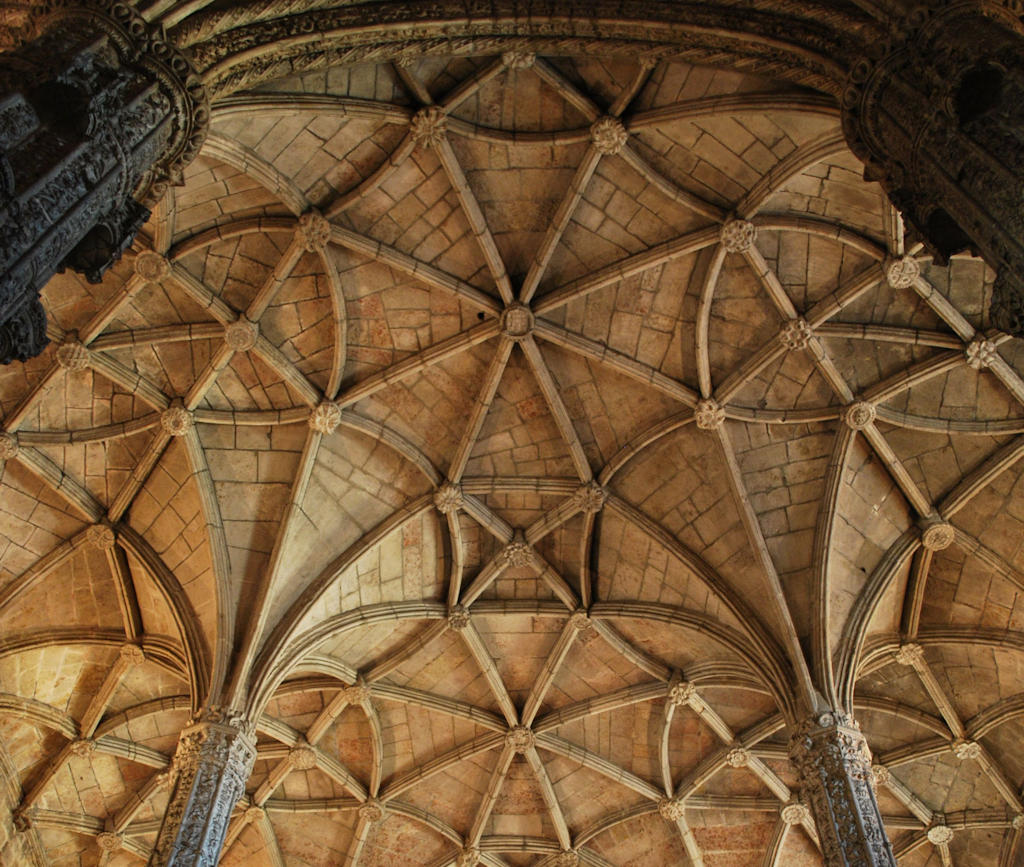Key Characteristics of Gothic Art and Architecture:
- Verticality and Height: Gothic architecture is known for its soaring verticality, reaching towards the heavens. Cathedrals and churches were designed with towering spires, pointed arches, and tall, slender windows, creating an ethereal sense of upward movement. The emphasis on height aimed to inspire awe, evoke a sense of divine transcendence, and connect the earthly with the celestial.
- Ribbed Vaults and Flying Buttresses: Gothic architecture revolutionized structural systems. Ribbed vaults replaced the heavy, solid stone ceilings of the Romanesque style, allowing for more expansive interiors and increased natural light. Flying buttresses, external supports that distributed the weight of the walls and roof, enabled the construction of larger windows and thinner walls, further enhancing the sense of openness and lightness.
- Pointed Arches and Tracery: Pointed arches became a hallmark of Gothic architecture, replacing the rounded arches of earlier styles. The pointed arches, with their graceful lines, distributed weight more efficiently and allowed for greater height and larger windows. Tracery, intricate stone or glass designs within the window frames, added decorative beauty and delicacy to the architectural composition.
- Stained Glass: Gothic architecture embraced the use of stained glass, which adorned the vast windows with vibrant, translucent colors and intricate narratives. These stained glass windows served as a medium for visual storytelling, depicting biblical scenes and saints. The play of light through the stained glass created a mystical atmosphere within the sacred spaces, evoking a sense of divine presence.
Lisbon.vip Recommends
Notable Structures of Gothic Art and Architecture in Portugal:
- Batalha Monastery (Mosteiro da Batalha): Located in the town of Batalha, the Batalha Monastery is a masterpiece of Portuguese Gothic architecture. It was built to commemorate the victory of the Portuguese over the Castilians in the battle of Aljubarrota. The monastery's facade is adorned with intricate stone carvings, and its interior features stunning ribbed vaults, delicate tracery, and a sense of grandeur and verticality characteristic of the Gothic style. The Unfinished Chapels, a part of the monastery, showcase exceptional craftsmanship and intricate detailing.
- Lisbon Cathedral (Sé de Lisboa): The Lisbon Cathedral, also known as Sé de Lisboa, is one of the oldest and most prominent cathedrals in Portugal. While the structure underwent various renovations and additions over the centuries, its origins date back to the 12th century, making it a significant example of Portuguese Gothic architecture. The cathedral's facade displays pointed arches, rose windows, and decorative stone carvings, reflecting the Gothic influence. Its interior features ribbed vaults, elegant columns, and an aura of solemnity and spirituality.
- Santa Maria da Vitória Monastery (Mosteiro de Santa Maria da Vitória): Commonly known as the Batalha Monastery, it is located in the town of Batalha. This UNESCO World Heritage site is an extraordinary example of Portuguese Gothic architecture. The monastery was built to commemorate the victory in the battle of Aljubarrota. It showcases intricate details, elaborate tracery, and delicate stonework. The Founder's Chapel, in particular, is a masterpiece of Gothic craftsmanship, featuring ornate tombs and exquisite sculptural elements.
- Viseu Cathedral (Sé de Viseu): Situated in the city of Viseu, the Viseu Cathedral is another notable example of Portuguese Gothic architecture. Dating back to the 12th century, the cathedral displays a combination of Gothic and Renaissance influences. Its facade exhibits pointed arches, rose windows, and decorative stone carvings. The interior features ribbed vaults, slender columns, and beautiful stained glass windows, creating a serene and spiritual atmosphere.
Enduring Influence and Legacy:
The legacy of Gothic art and architecture extends far beyond the medieval era. The principles and aesthetics of the style influenced subsequent periods, such as the Gothic Revival in the 19th century. Gothic architecture's emphasis on verticality, pointed arches, and delicate tracery can be seen in later structures, including churches, universities, and government buildings across Europe and beyond.Gothic art and architecture captivate us with their ethereal beauty, celestial aspirations, and innovative structural systems. The soaring spires, pointed arches, and intricate details of Gothic cathedrals and churches transport us to a bygone era of spiritual devotion and artistic excellence. As we marvel at these architectural marvels and the delicate artistry of stained glass, we are reminded of the enduring legacy and profound impact of Gothic art and architecture on European culture and the world at large.



